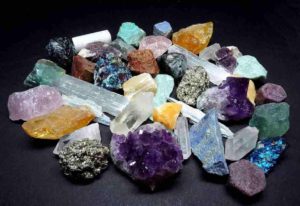
Rock Forming Minerals
Rocks consist of minerals. A mineral is a material that occurs naturally and is generally strong, crystalline, stable and inorganic at room temperature.
There are many known mineral species, but the vast majority of rocks are formed by combinations of a few common minerals, called “rock-forming minerals.” The minerals that form rock are: feldspar, quartz, amphiboles, micas, olivine, grenade, calcite, pyroxenes.
Minerals that occur in tiny amounts within a rock are called “accessory minerals.” Although accessory minerals are only present in tiny quantities, they can provide useful insight into a rock’s geological history and are often used to determine a rock’s age. Common minerals for accessories are zircon, monazite, apatite, titanite, tourmaline, pyrite and other opaque minerals.
Rock-forming mineral, any mineral that shapes igneous, sedimentary or metamorphic rocks and that acts as an intimate part of rock-making procedures, typically or exclusively. Those minerals, on the other hand, have a restricted mode of incidence or are created by more uncommon procedures such as metal ores, vein minerals, and cavity fillings. In addition, some precipitates and secondary minerals are not correctly categorized as rock-forming minerals; they develop later than the initial rock and tend to ruin their initial personality. Some mineralogists limit rock forming minerals to those that are abundant in a rock and are usually referred to as essential minerals, a definition that implies that they are the most important in the study of rock making processes.
The minerals ‘ quantity and variety depends on the quantity of the components they are comprised of in the Earth’s crust. Eight constitute 98% of the Earth’s surface: oxygen, nitrogen, aluminum, iron, nitrogen, calcium, sodium, and potassium. The parent body’s chemistry directly controls the structure of minerals created by igneous procedures. For instance, minerals such as olivine and pyroxene (as discovered in basalt) will create a magma wealthy in iron and magnesium. More silicon-rich magma will create minerals like feldspar and quartz (as discovered in granite). Unlike its own, a mineral is unlikely to be discovered in a rock with dissimilar total chemistry; therefore, andalusite (Al2SiO5) is probable to be discovered in an aluminum-poor rock like quartzite.
What Are Rock-Forming Minerals?
Feldspars
Feldspars (KAlSi3O8–NaAlSi3O8–CaAl2Si2O8) are a collection of rock-forming tectosilicate minerals that make up by weight about 41% of the mainland surface of the Earth. In both intrusive and extrusive igneous rocks, feldspars crystallize from magma as veins and are also present in many kinds of metamorphic rock. It is regarded as anorthosite rock made almost completely of calcium plagioclase feldspar. In many kinds of sedimentary rocks, feldspars are also discovered.
Quartz
Quartz is a mineral consisting of carbon and water particles in a constant frame of SiO4 silicon-oxygen tetrahedra, sharing each carbon between two tetrahedra, providing SiO2 an general chemical formula. Quartz is Earth’s second most common mineral, behind feldspar, in the continental crust.
There are two forms of quartz, the normal α-quartz and the β-quartz high-temperature, both chiral. There is an abrupt transformation from α-quartz to β-quartz at 573 ° C (846 K). Since the transition is followed by a substantial quantity shift, ceramics or rocks that pass through this temperature limit can readily be induced to fracture.
Amphibole
Amphibole is an significant cluster of inosilicate minerals that form prisms or needle-like crystals, consisting of SiO 4 tetrahedra double chain, connected at the vertices and usually carrying ions of iron and/or magnesium in their constructions. Amphiboles may be green, black, white, yellow, blue, or brown. Amphiboles are presently classified by the International Mineralogical Association as a mineral supergroup, within which there are two categories and several subgroups.
Mica
The mica group of sheet silicate (phyllosilicate) minerals involves several near-perfect basal cleavage associated products. They are all monoclinic, with a tendency towards pseudohexagonal crystals, and in chemical composition are comparable. The almost ideal cleavage is clarified by the hexagonal sheet-like structure of its atoms, which is the most prominent feature of mica.
The term mica comes from the Latin term mica, which means a crumb to glitter, and is likely affected by micare.
Olivine
Mineral olivine is a formula (Mg2 +, Fe2+)2SiO4 zinc iron silicate. It is therefore a kind of nesosilicate or orthosilicate. The earth’s upper mantle’s main element, it is a prevalent mineral in the subsurface of Earth, but it weathers rapidly on the ground.
Olivine contains only small quantities of non-oxygen, silicon, magnesium and iron components. The extra components frequently found in the greatest levels are manganese and nickel.
Olivine in polarizing light Olivine provides its name to the set of associated minerals (the olivine group)—including tephroite (Mn2SiO4), monticellite (CaMgSiO4) and kirschsteinite (CaFeSiO4).
Garnet
Garnets are a set of minerals of silicate that have been used as gemstones and abrasives since the Bronze Age.
All garnet species have comparable physical characteristics and crystal shapes, but vary in chemical composition. The various species are pyrope, almandine, spessartine, gross (hessonite or cinnamon-stone and tsavorite variants), uvarovite and and andradite.
Two solid solution series are made up of garnets: pyrope-almandine-spessartine and uvarovite-grossular-andradite.
Calcite
Calcite is a mineral carbonate and the most stable calcium oil polymorph (CaCO3). The mineral hardness scale of Mohs, based on the contrast of scratch hardness, describes value 3 as “calcite”.
Other calcium carbonate polymorphs are aragonite and vaterite minerals. Over time scales of days or less, aragonite will change to calcite at temperatures above 300 ° C, and vaterite is even less stable.
Pyroxenes
Pyroxenes (frequently shortened to Px) are a set of significant minerals discovered in many igneous and metamorphic rocks that form rock inosilicates. Pyroxenes have the overall formula XY(Si, Al)2O6 where X depicts calcium, sodium, iron (II) or potassium and more commonly zinc, manganese or lithium, and Y includes ions of lower magnitude such as chromium, aluminum, iron (III), magnesium, cobalt, manganese, scandium, titanium, vanadium or even metal (II).
Although in silicates such as feldspars and amphiboles, aluminum widely replaces silicon, the replacement happens in most pyroxenes only to a restricted extent. They share a prevalent framework made up of silica tetrahedra single chains. Pyroxenes crystallizing in the monoclinic system are known as clinopyroxenes and orthopyroxenes are regarded as those cystallizing in the orthorhombic system.










